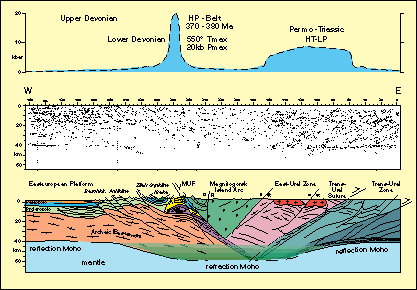The crustal-scale seismic image from URSEIS CMP-reflection profiling shows a doubly-vergent fabric of the collisional belt with a significant crustal root. The structures are the result of two major, partly superimposed collisional events:
- the development of an Upper Devonian W-facing accretionary complex with an exhumed subduction-related HP-belt resulting from an continent-arc collision and
- a Permo-Triassic collision with an eastward accretion of the Trans-Uralian terranes and general intracontinental shortening.
The reflectivity of the Moho is variable from highly reflective beneath the foreland and the hinterland to non-reflective beneath the root.
The orogenic root zone is defined by wide-angle data and is poorly imaged in the near-vertical reflection data: it is ca . 15 km thick, mafic (high Vp) and has a low poisson's ratio.
Gravity and petrophysical modelling show that the crustal root is composed of high-density mafic eclogitic rocks which inhibits Moho reflectivity and inhibited together with the supra-crustal oceanic fragments the buoyancy potential of the Uralian crust.
The Urals evolved since collision near isostasy and never departed far from equilibrium.
Mantle Reflections from the explosive high-angle reflection profiling present beneath eastern and western edges, show prominent structures at 25 s TWT (ca 85 km) and at 35-44 s TWT (>150 km). This Nikolaevka Reflection Sequence is one of the deepest ever measured CMP reflections.


